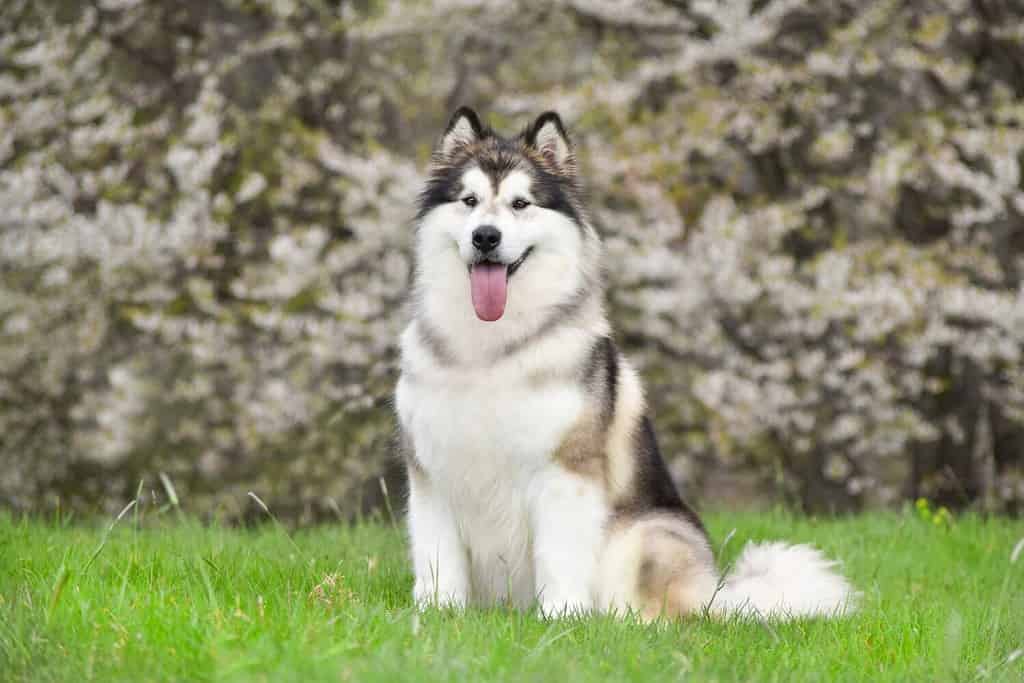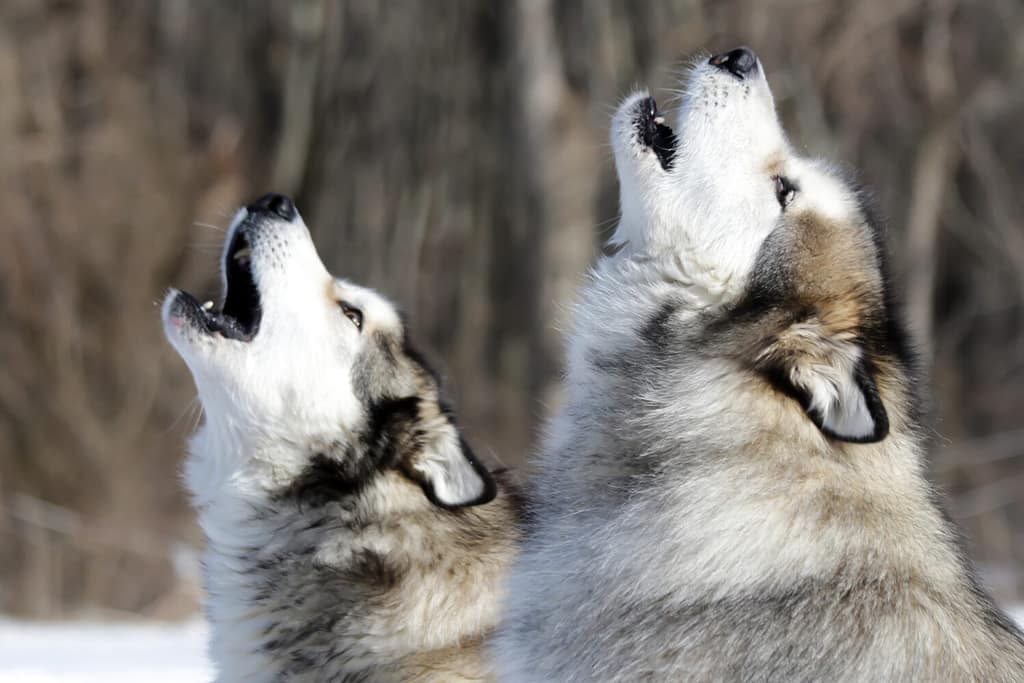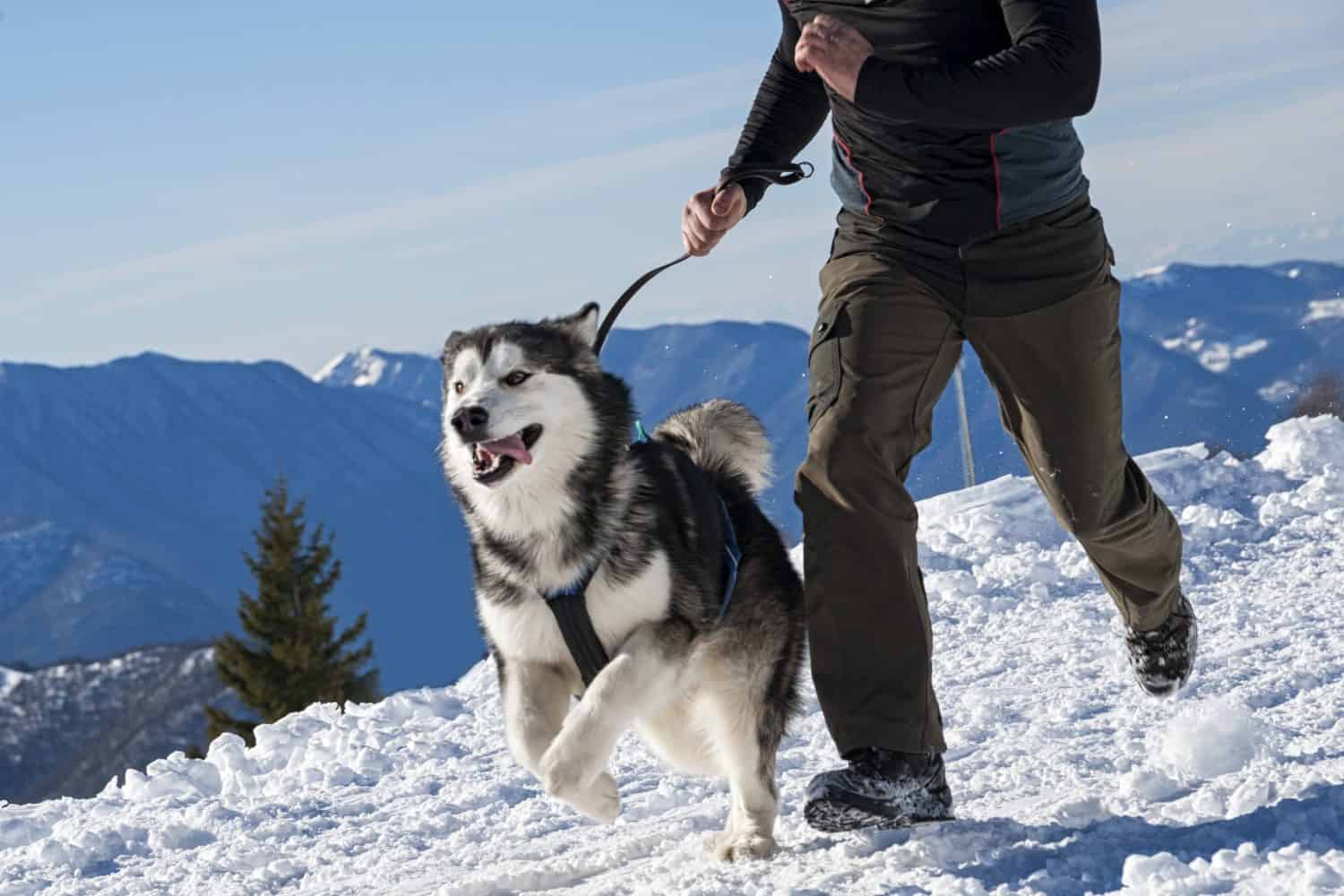Are you familiar with the Alaskan Malamute? It looks a lot like a Siberian husky, but larger and with more rounded ears and a curved tail. Alaskan Malamutes served an important role for the indigenous Malimuit Iñupiat people of Alaska. These strong working dogs, bred to withstand the extreme cold and harsh conditions of the Arctic, helped their human companions survive. The Alaskan Malamute has an average lifespan of approximately 10 to 14 years. They are, however, prone to certain health problems that can cause complications or shorten their lives. Read on to learn more about this breed.
Is an Alaskan Malamute the Dog for Me?

Alaskan Malamutes make great companions, but they require special care.
©Hanna Borysenko/Shutterstock.com
If you are wondering whether an Alaskan Malamute might be the right dog for you, you probably don’t own a dog sled or live in the extreme northern tundra. You would already know how valuable such a dog would be if that were the case. Alaskan Malamutes, perhaps the oldest of the Alaskan dog breeds, have provided assistance and companionship to Indigenous people of the region for thousands of years. But how would an Alaskan Malamute fare in your home?
This large and fluffy breed needs lots of exercise. After all, they were bred to work hard, under the harshest of conditions. Alaskan Malamutes need plenty of activity to stay happy and healthy. They love to hike and run, especially over long distances. They can easily keep up with a bicycle rider, a jogger, or a cross-country skier. If you want to own one of these dogs, be prepared to get up and move.
Also, be ready to do a lot of brushing. An Alaskan Malamute has lots and lots of fur by design. They shed from their thick, double coat constantly. And they blow their coats twice a year, usually in the spring and the fall. Do not add an Alaskan Malamute to your household if you do not want to brush your dog frequently and deal with dog hair all year round.
Health Issues that May Affect an Alaskan Malamute

Let’s talk about the many health issues that may affect Alaskan Malamutes.
©Kate Lussier/Shutterstock.com
Alaskan Malamutes are generally healthy dogs with a comparatively long lifespan for a large breed. However, several different health issues can affect this breed and may even shorten their lives. Many disorders that may affect an Alaskan Malamute get inherited from generation to generation. Genetic testing and careful breeding can help eliminate much of the risk for these health problems. Avoid obtaining pups from disreputable breeders to decrease the chances of getting an unhealthy dog.
Hip Dysplasia
Hip dysplasia is common among large and giant dog breeds. This inherited disorder causes poor development of the hip joint and commonly affects Alaskan Malamutes. Hip dysplasia causes pain and can lead to arthritis and the complete deterioration of the joint as the dog gets older. Owners must carefully manage their dog’s weight to reduce the risk of hip dysplasia. Treatments may include dietary supplements, medication, or surgery.
Elbow Dysplasia
Alaskan Malamutes may also suffer from elbow dysplasia. This disorder, which also often affects Australian cattle dogs, is similar to hip dysplasia. It affects the elbow, or the middle joint on the front leg, between the shoulder and wrist. Elbow dysplasia is a progressive disease that often leads to debilitating arthritis. Surgery is the most effective treatment.
Chondrodysplasia
Alaskan Malamutes may be prone to chondrodysplasia, a type of dwarfism. This genetic disorder causes puppies to have limb deformities. The only way to prevent this disorder is to genetically test dogs and breed responsibly.
Hypothyroidism
A dog with hypothyroidism cannot produce enough thyroid hormone. Signs of hypothyroidism in dogs resemble those seen in humans. They may gain weight, despite having no change in their diet or exercise level. They may be lethargic and want to snuggle more because they feel cold. Their coat may become dry, and they may have skin issues. Treatment may require prescription medication.
Polyneuropathy
Research indicates that polyneuropathy is a hereditary disease that can affect the lifespan of an Alaskan Malamute. This disorder affects multiple nerves throughout the dog’s body. It can cause a myriad of symptoms, including mobility issues, exercise intolerance, voice changes, difficulty breathing, and more. The severity of the disease may vary, but in highly affected dogs, euthanasia may be the only humane solution.
Bleeding Disorders
Alaskan Malamutes may suffer from von Willebrand’s disease, the most common type of bleeding disorder in dogs. They may also inherit thrombopathia, which can cause faulty platelets and result in excessive bleeding or bruising. Other bleeding disorders known to affect Alaskan Malamutes include coagulation factor VII deficiency which causes problems with blood clotting, and factor IX deficiency, which causes hemophilia.
Vision Problems
Alaskan Malamutes can suffer from vision problems such as day blindness and cataracts. Day blindness, also known as hemeralopia, causes difficulty seeing clearly in bright light. This autosomal recessive trait has no treatment. Carriers of the gene may be identified when they produce an affected puppy. Cataracts in dogs, meanwhile, may be hereditary or may arise from nutritional issues, other diseases like diabetes, or infections. Treatment involves surgery to remove the cataracts.
How to Find the Healthiest Alaskan Malamute Puppy

Don’t settle for just any Alaskan Malamute puppy. Invest in one from a high-quality breeder.
©Kseniia Grigoreva/Shutterstock.com
Knowing that many hereditary health issues can seriously affect an Alaskan Malamute, you might wonder how to find a healthy puppy that will likely stay that way. Excellent breeders will run genetic tests on their dogs to make sure they do not carry harmful or potentially deadly genes. If a breeding pair produces puppies with recessive genetic disorders, they will refrain from breeding those dogs further. Not every disease or disorder can be prevented, but many can with careful breeding. Obtaining your Alaskan Malamute puppy from a conscientious breeder will help ensure that you get the healthiest dog possible.
How to Keep Your Alaskan Malamute Healthy

Keeping your Alaskan Malamute healthy requires a commitment to exercise and proper nutrition.
©COLOMBO NICOLA/Shutterstock.com
Maintaining the health of your Alaskan Malamute can help increase its lifespan. Make sure you provide excellent hygiene for your dog. Brush its teeth regularly to prevent dental problems. Brush its hair to prevent matting and keep its coat and skin healthy.
Obesity causes or exacerbates many health issues in dogs like Alaskan Malamutes. Make sure that you feed your dog a healthy and well-balanced diet. Good quality dry food should make up the bulk of your dog’s food intake. Also, be certain to provide your Alaskan Malamute with plenty of exercise. This breed was designed for long, hard work, so take it on long walks, hikes, or runs outside as often as you can.
Finally, make sure you provide your Alaskan Malamute with plenty of attention and companionship. These highly social dogs do well with other dogs. They enjoy talking with each other and with people, even though they don’t vocalize nearly as much as Siberian huskies. Keep their minds engaged by providing them with stimulating activities, such as agility training or outdoor activities in places outside their regular routine.
The photo featured at the top of this post is © SteveOehlenschlager from Getty Images, Зображення користувача 4zevar/ via Canva.com
Ready to discover the top 10 cutest dog breeds in the entire world?
How about the fastest dogs, the largest dogs and those that are -- quite frankly -- just the kindest dogs on the planet? Each day, AZ Animals sends out lists just like this to our thousands of email subscribers. And the best part? It's FREE. Join today by entering your email below.
Thank you for reading! Have some feedback for us? Contact the AZ Animals editorial team.






